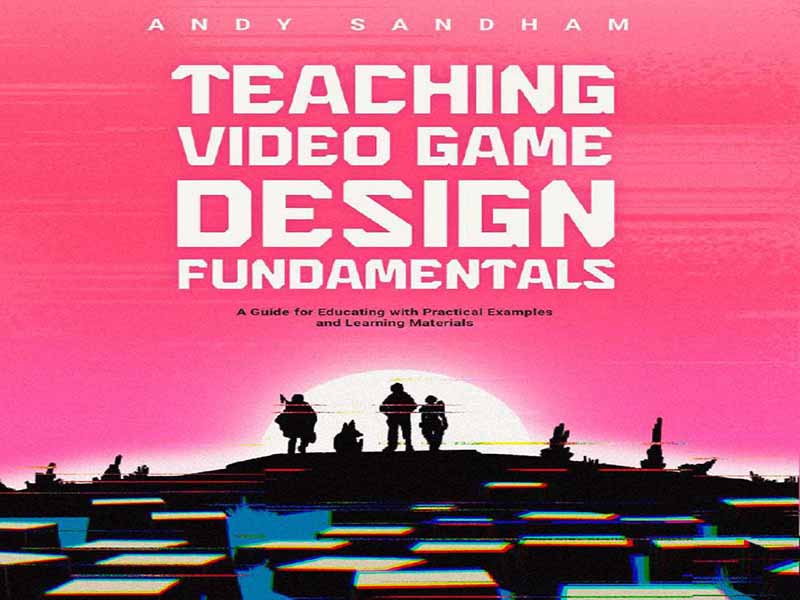- عنوان کتاب: Teaching Video Game Design Fundamentals
- نویسنده: Andy Sandham
- حوزه: طراحی بازی
- سال انتشار: 2025
- تعداد صفحه: 409
- زبان اصلی: انگلیسی
- نوع فایل: pdf
- حجم فایل: 11.2 مگابایت
من در زمان تولد طراحی بازی آنجا بودم. جملهی خیلی جالبی بود، نه؟ خوب یادم هست. در دههی ۹۰، در حالی که در اتاق پشتی یک استودیوی بازیسازی کثیف نشسته بودم و با حواسپرتی داشتم چند کاشی ایزومتریک رنگی را به سیاه و سفید تبدیل میکردم، ناگهان یک مرد خوشقیافه وارد اتاق شد و شروع به گپ زدن با برنامهنویس کرد. او توجهش را به من جلب کرد. “شما تازهکار هستید.” زیر لب گفتم: “بله،” “سلام، من طراح هستم.” مرد خوشقیافه گفت. “اممم؟” با کمی گیجی گفتم – “شما هنرمند یا برنامهنویس نیستید؟” “نه. من یک طراح بازی هستم.” با لکنت گفتم: “این… یه شغله؟” “آره. این یه شغله. هر روز، روز مدرسهست، درسته؟” او پوزخندی زد. “باید امتحانش کنی. خیلی باحاله.” و با یک چشمک، رفت. با خودم فکر کردم، وای، با نگاه به این استادِ در حالِ رفتن، با کفشهای کتانی مُد روزش (قطعاً کفش کتانی، نه کفشهای کتانی قدیمیِ بیروح، نه ریشدار!)، مدل موی ذرتیِ جذاب و لباسِ صدفیِ مُد روز که شبیهِ توسعهدهندگانِ بازی نبود. و بعد به کفشهای کتانیِ لکهدار و دوباره به بلوکهای ۸ بیتیِ سیاه و سفیدِ ملالآورم نگاه کردم. و با خودم فکر کردم «اون یارو باحال انگار داشت خوش میگذروند». من هم کمی از این حس رو میخواستم. همون موقع تصمیم گرفتم که من هم میخوام طراح بازی بشم. مدتی طول کشید. اون «اولین طراحان بازیِ تاریخ» ™ کار راحتی نداشتن – اما کمکم، جا افتاد. صنعت بازی کمکم متوجه شد که به کسی توی تیم نیاز داره که طراحیِ کلیِ بازی، حس و حال، روایت، طراحیِ مراحل، حتی تجربه کاربری (که اگه اون موقع از این اصطلاح استفاده میکردیم، فکر میکردیم یه نوع بنزینِ جدیده) رو مدیریت کنه. برای آزمایش کردنش، برای تکرارش، برای اصلاحش. طراحی بازی کمکم به یه «چیز» تبدیل شد. یکی از، در واقع اولین قدم، در سهگانهی مقدس توسعهی بازی – هنر، کد – و حالا – طراحی بازی. و با پیوستن طراحان بیشتر به این عرصه، به اشتراک گذاشتن مفاهیم، ایدهها و نظریهها، و کتابهای نظری طراحی بازی شروع به جلب توجه کردند، اصول و نظریههای اصلی طراحی بازی شروع به شکلگیری کردند. رشتهی طراحی بازی متولد شده بود. و وای! طراح بازی بودن تمام چیزی بود که میخواستم باشد. طراحی مراحل، معماها، مکانیکها، روایتها. کلید شیرینیفروشی به دستم داده شد. آدم باحال درست میگفت. ساختن بازیها سرگرمکننده بود. و این چیزی است که این کتاب در مورد آن است. طراحی بازی. نه هنر، برنامهنویسی یا تهیهکنندگی. طراحی بازی. به طور خاصتر، آموزش طراحی بازی، امیدوارم حداقل با کمی سرگرمی. اما چگونه طراحی بازی را آموزش میدهید؟ کاربرد عملی تکنیکهای طراحی در موتورهای بازی مربوطه و نرمافزارهای خاص بدیهی است که حیاتی است و همیشه به دانشجویان ما کمک کرده است تا نقشهایی را در صنعت پیدا کنند. اما حدس میزنم شما بدون نقشه به بیابان نمیروید یا بدون نقشه خانه نمیسازید، درست است؟ علاوه بر دانش عملی، اهمیت آموزش تئوری و اصول طراحی بازی به دانشجویان اکنون به رسمیت شناخته شده است. آموزش طراحی بازی شامل تعیین ترتیب و اولویت این اصول است و با توجه به 12 سال تجربه من در تطبیق و تکرار تدریجی این طرحهای درسی، پیشنهاد میکنم ترتیب و ارائه مراحل اساسی کلیدی هستند. اینها هفت سخنرانی کلیدی نظری هستند که در دست دارید. اولین قدمها برای فرستادن دانشجویان نوپای طراحی بازی خود به رشته همیشه در حال پیشرفت و الهامبخش طراحی بازی. آنها نه تنها “آزمایش شده” و آماده آموزش هستند، بلکه برای تکرارها، تطبیقها و اصلاحات شخصیسازی شده شما نیز آماده هستند. هر طور که میخواهید سفارشی کنید. امیدوارم از تدریس این درسها و در نهایت نقش خود در شکلدهی به نسل بعدی طراحان بازی لذت ببرید، که تقریباً به زودی یک یا دو چیز به ما خواهند آموخت.
I was there at the birth of Game Design. Quite a statement, right? I remember it well. Back in the 90s, while sitting in the back room of a grubby game studio, absent- mindedly dithering some colour isometric tiles into black and white, when a cool-looking guy entered the room and started chatting with the coder. He turned his attention to me. “You’re new.” “Yes,” I mumbled. “Hi, I’m the Designer.” Said cool guy. “Uh?” I blurted, somewhat nonplussed – “You’re not an artist or a programmer?” “Nope. I’m a Game Designer.” “That’s… a job?” I stammered. “Yup. That’s a job. Every day is a school day, right?” He grinned. “You should try it. It’s fun.” And with a wink, he was off. Wow, I thought, looking at this departing guru, with his trendy sneakers (definitely sneakers, not drab old trainers, no siree!), cool cornrow hairdo, and hip, non-game developer-looking shell suit. And then I looked down at my stained definitely trainers and back at my dismal black and white 8-bit blocks. And I thought “That Cool guy looked like he was having FUN.” I wanted some of that. I decided then and there I wanted to be a Game Designer too. It took a while. Those “First Game Designers ever” ™ didn’t have it easy – but gradually, it began to sink in. The industry began to recognise that it needed someone on the team to be managing the overarching game design, the feel, the narrative, the level design, even the UX (which we would have assumed was a new type of petrol if you’d used the term back then). To test it, to iterate it, to correct it. Game design gradually became a “thing.” One of, indeed the first step, in the holy triumvirate of game development – Art, Code – and now – Game Design. And as more designers joined the fray, sharing concepts, ideas, and theories, and theoretical game design books began to gain traction, the core principles and theories of game design began to take shape. The discipline of Game Design had been born. And WOW! Being a Game Designer was everything I wanted it to be. Designing levels, puzzles, mechanics, narratives. Being handed the keys to the sweet shop. Cool guy was right. Making games WAS fun. And that’s what this book is about. Game Design. Not art, programming, or producing. Game Design. More specifically, teaching Game Design, hopefully with at least some of the fun included. But how do you teach Game Design? Practical application of design techniques in relevant game engines and specific software is obviously vital and has always helped our students find roles across the industry. But I’m guessing you wouldn’t navigate into a wilderness without a map, or build a house without a plan, right? In addition to practical knowledge, the importance of teaching students the theory and principles of game design is now recognised. Teaching game design involves determining the order and priority of these principles, and from my 12 years of gradually adapting and iterating these lesson plans, I would suggest the order and delivery of the foundational steps are key. These are the seven key theoretical lectures you hold in your hand. The first steps for sending your nascent game design students out into the ever-advancing and inspirational discipline of game design. They are not only “road-tested” and ready to be taught, but also ready for your own personalised iterations, adaptations, and tweaks. Customise as you will. I hope you enjoy teaching these lessons, and ultimately your role in shaping the next generation of game designers, who will almost certainly soon be teaching us a thing or two.
این کتاب را میتوانید از لینک زیر بصورت رایگان دانلود کنید:
Download: Teaching Video Game Design Fundamentals




































نظرات کاربران